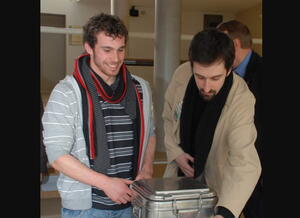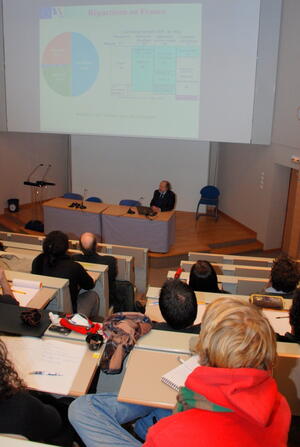Masters of Fusion
The presence on French soil of two major fusion projects, ITER and the Laser Mégajoule (LMJ), led France's academic authorities to establish a Master's degree program in Fusion Science in 2006.
The two-year program is offered by ten participating higher education institutions in France, but all students have one thing in common: they spend the last quarter of their course either at Cadarache's INSTN, or in Bordeaux, close to the LMJ installation, and do a six months internship in a fusion lab or installation.
To this day, more than one hundred students have earned the Master's degree in Fusion Science.
Last Thursday, 4 February, 23 students gathered in the INSTN amphitheatre near the Château de Cadarache. They were welcomed by Francis Kovacs, Deputy Director of CEA-Cadarache; Guy Bonnaud, in charge of the Fusion Science Master's program at INSTN; Yves Sarazin, of INSTN-Cadarache; and Jean Jacquinot, former Director of JET and Tore Supra, who gave a presentation on "The socio-economic implications of magnetic confinement fusion."
Christophe Guillemaut, 29—who already holds a Master's degree in physics—and Germain Broydé, 21, are among the three students who have been accepted for an internship at ITER. They will both work on divertor-related matters.
"I remember reading about fusion and the JET installation in a science magazine when I was 12 and being totally enthralled with it," says Christophe. "Later on, while studying physics, fusion appeared to me as the perfect mix of theory and engineering."
Alongside Richard Pitts in the FST Department, Christophe will tackle computer modelling of energy loads on the ITER divertor.
Broydé, despite his young age, comes to ITER with rich international experience. A third-year student at the Arts et Métiers Engineering School, he has studied in New Zealand and "discovered the nuclear world" at the Indian Institute of Technology in Kampur. His "passion" is energy: he'll be working with Frédéric Escourbiac on thermomechanical analysis of the ITER divertor.
Of the 23 magnetic fusion students who gathered last Thursday at INSTN-Cadarache, almost half will be doing their internship at Tore Supra. "It will be a great privilege to be working in such environments," Guy Bonnaud told them in his welcoming address.



